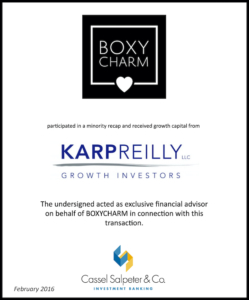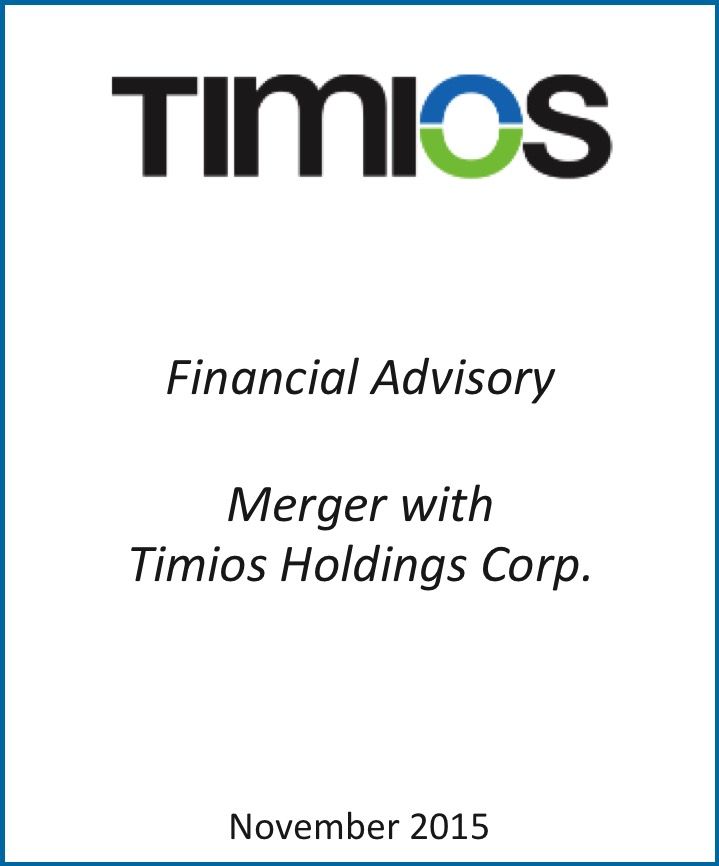Boxycharm participated in a minority recap and received growth capital from KarpReilly
- Background: Headquartered in Miami, FL, BOXYCHARM is the premier monthly beauty box subscription service, delivering 4-5 full-size and luxury travel-size products of well-known, popular, chic, and up-and-coming cosmetic brands. BOXYCHARM’s unique value proposition is their ability to provide a combination of the newest and highest quality brands and products in full-size offerings, while most competitors offer sample-size products.
- Cassel Salpeter:
- Served as financial advisor to the Company
- Ran a competitive capital raise process, identifying and contacting over 100 strategic and financial parties
- Structured a minority recap and growth capital raise with a built-in option for a majority recap
- Challenges:
- Earn-out structure to increase valuation of capital infusion contingent on success-based performance benchmarks
- Minority shareholder buyout
- No prior relationship with investor
- Outcome: In February 2016, KarpReilly Investments, LLC invested in BOXYCHARM. KarpReilly is a private investment firm based in Greenwich, CT.
Succession plans are key to protecting your business when the unthinkable happens
To view the original article, click here.
By James S. Cassel
August 17, 2015
Although there are probably many things you would rather discuss with your CEO than how to proceed if he or she unexpectedly dies or falls victim to some other tragedy, the fact is that you must. Companies without crisis-succession plans are at significant risk.
History has proved that the way companies handle these crisis situations can make or break them. A 2014 survey by the National Association of Corporate Directors reveals that two-thirds of publicly and privately held companies in America had no succession plan. This is for planned or unplanned succession.
Public companies are more likely and may be required to have succession plans in place, but very few private companies do, particularly those that are family-owned.
Losing a CEO to an unforeseen circumstance such as a tragedy, termination or resignation can create more turmoil than losing a leader to a situation you can see coming, such as a terminal illness or an orderly, planned change. Sudden losses can leave employees and other key stakeholders devastated and bewildered. Without a designated leader or clear path to the future, the business can suffer. This can be particularly disastrous for smaller companies.
While it is not uncommon for people to think their company could never survive the death of the CEO, the fact is that more often than not, it could survive with proper planning. Well strategized, efficiently executed succession plans bring benefits on multiple levels. In addition to providing a roadmap to help your company deal with the crisis, they put investors and shareholders at ease.
Of course, the core of your succession plan should be more than processes — you also must identify who will assume your CEO’s responsibilities. You should build a bench of candidates. In some family businesses, a family member with little history with the company might step in, so it is critical to have a succession plan to ensure the successor has adequate background and knowledge.
You also will have to address training: What kind of knowledge will the ascending CEO or interim leader need? Was there sufficient knowledge transfer prior to the need for it? Appointed successors, like an understudy in a Broadway production, must be well informed and ready to hit the ground running. This preparatory training should be an ongoing process.
Some businesses may need outside help on an interim basis, and there are companies that provide interim leadership assistance.
Succession planning should not only apply to your CEO; it should also include other senior positions such as President, CFO, CTO and CMO. Passwords, systems and processes should all be documented so your business can continue operating as usual.
A sound succession plan will contemplate how you will communicate with clients, customers, vendors, employees, investors and partners. Your key audiences should not learn about the death of your CEO from the news media, so you will need a public-relations and crisis-communications strategy that outlines how to best notify all your key internal and external audiences. It is interesting to observe the upfront, open manner in which Warren Buffett of Berkshire Hathaway (NYSE:BRK.A) is dealing with his succession. Buffet’s approach is much more well received than the way former U. S. Secretary of State Alexander Haig announced that he would be in charge after former President Ronald Reagan was shot (especially given the fact that the transition plan in the Constitution calls for the vice president to assume the leadership role).
If your business is family-run or family-owned with one family member playing a key role such as CEO, part of the succession plan should include not only a replacement CEO, but should also ensure there is an appropriate family member designated to maintain communication between the business and the family.
Consider “key person” insurance policies that can be owned by the company. The liquidity of these policies can offer the company the breathing room to survive a crisis. Some bank loans provide for calling the loan due if a certain person passes away, and that can be strategically insured around with a key person policy.
Another key consideration: bereavement services for grieving employees. In Miami, the Children’s Bereavement Center, which provides assistance to people of all ages, offers varied support groups and other services for bereaved adults, and resources for professional organizations and businesses dealing with trauma or crises. They are available on short notice.
Although the days and weeks following a tragic loss will certainly not feel like business as usual, they should be guided by a sound succession plan to keep the company on track with as few disruptions as possible. Investing a little time now to put the necessary plans and infrastructure in place can make all the difference when the unthinkable happens.
James Cassel is co-founder and chairman of Cassel Salpeter & Co., LLC, an investment-banking firm with headquarters in Miami that works with middle-market companies. He may be reached via email at jcassel@casselsalpeter.com. His website is www.casselsalpeter.com
Attracting and retaining top talent: a growing obstacle for South Florida businesses
To view the original article, click here.
By James S. Cassel
July 12, 2015
 Maintaining a strong workforce is becoming an increasingly significant barrier to growth for South Florida’s middle-market businesses. Finding, attracting, and retaining quality talent is a tricky proposition in a region with a limited labor pool and low unemployment rates.
Maintaining a strong workforce is becoming an increasingly significant barrier to growth for South Florida’s middle-market businesses. Finding, attracting, and retaining quality talent is a tricky proposition in a region with a limited labor pool and low unemployment rates.
Deloitte’s newly published “Mid-Market Perspectives: 2015 Report on America’s Economic Engine” identifies employee turnover as a major concern for middle-market companies.
Clearly, there is more value in cultivating existing talent than having a revolving door of employees. So, how can you build a strong, loyal team in South Florida?
First, have the right perspective. Do not feel overwhelmed and assume that sweeping corporate changes will be required. Often, we can achieve a great deal by making a series of small adjustments, and continuing to make other adjustments as we build on our success. Develop a practical plan and identify realistic, attainable goals and objectives.
At all times, keep a close pulse on your employees. It can be easy for business owners to get so consumed by day-to-day operations that they lose touch with their teams, a costly mistake. Are your employees engaged, motivated and happy? How can you maximize engagement? If you have good employees who are unhappy in their current positions, can you find other opportunities within the company so you can keep them around? If not, outplacement may be best for all parties.
Your compensation packages, including cash and benefits, should be competitive. While many companies in recent years have tended to avoid raises, increased competition and poaching of employees is making it critical for employers to become more generous. Competitive compensation packages can reduce your exposure to turnover too. Even Walmart is having to address the need for wage increases.
Usually, employees will reject job offers for lateral moves unless they perceive significant disparities in working conditions and compensation. Keep your eyes and ears open so you know what other businesses in your industry are doing. Websites like PayScale and Glassdoor can help you assess average compensation data about different industries and job roles.
Working conditions, benefits and flexibility also are important. While it is important to offer 401(k) programs (ideally with matching contributions), these benefits will not support retention if your employees do not use them. This is often the case with younger employees who opt not to contribute to their 401(k) plans (although they should). Ensure that your employees are educated on the importance of contributing, no matter how entry-level their salaries.
It also helps if your office has a “cool factor.” Every generation of employees has different needs and wants. Trendy-looking, modern offices in desirable neighborhoods and touches such as free gourmet coffee and snacks in break rooms appeal to millennials and Gen X-ers.
When recruiting and hiring, conduct as much due diligence as possible. Personality tests can help, as well as meticulously following up with references. Your current employees can be great resources for recruiting. Leverage them when appropriate, as they probably know your company better than outsiders and would be more engaged to stay at companies where they are surrounded by colleagues they helped recruit.
Routine evaluations can also boost employee loyalty and performance. Embrace the opportunity to let your team members know how they are performing, praise their strengths and achievements, and provide guidance on how to reach their career objectives. At the same time, use the opportunity to solicit their thoughts and feedback, take good notes, and follow through on their comments.
Encourage employees to interact in structured social environments, such as barbeques, movie nights or whatever tickles their fancy. While many companies have stopped providing annual company picnics, it may be time to resurrect them. The more your employees enjoy each other’s company, the more apt they are to work well together. Consider employee recognition initiatives too, and perhaps pair them with these social activities. Corporate community involvement projects can help increase job satisfaction and engagement. Identify organizations your employees would be most inclined to support.
Career development is critical. Employees who feel challenged and believe they are learning are more likely to stick around. A current issue with the millennial generation, for example, is that most recent college grads will have four or five jobs in their first decade of employment. Bearing that in mind, many companies are offering less training and investing fewer resources to advance employees out of fear of wasting time and money. This can be a mistake: Bored employees are more likely to begin looking elsewhere for stimulation.
Attracting and retaining quality employees is no easy task. By taking the right steps to build a strong team, you can gain a competitive edge and position your business for maximum growth and success.
Middle-market businesses should help growth industries
To view the original article, click here.
By James S. Cassel
June 14, 2015
 While the technology and healthcare/biotech industries in South Florida continue to gain strength and momentum, the region’s middle-market businesses are not properly positioning themselves to serve these industries and benefit from their growth.
While the technology and healthcare/biotech industries in South Florida continue to gain strength and momentum, the region’s middle-market businesses are not properly positioning themselves to serve these industries and benefit from their growth.
There can be significant revenue opportunities for those that make the financial and other commitments necessary to position themselves to fulfill the needs of these growth businesses for highly qualified suppliers, subcontractors, and service providers. Too often, these growth businesses feel a need to look beyond South Florida for support because they do not believe their needs can be handled locally — a void that must be addressed. Right or wrong, this is the perception in the marketplace.
Based on our experience advising middle-market businesses seeking growth opportunities, the following is practical guidance for businesses that cater or want to begin catering to these growth industries:
Create a business-development strategy. Identify the key businesses you want to serve and pinpoint the ones you are best-suited to begin serving in the near or long term. Develop a plan for getting in front of these businesses to assess their needs and offer your services.
Identify the areas of your business, including products or services that you provide, which you may need to trim or expand in order to serve growth industries. Some of this may require partnering with or outsourcing work to other companies, locally, or in other parts of the United States, or internationally.
Consider investing in your team by providing educational or training opportunities and/or by adding head count. Hiring the best talent can be an expensive commitment, especially for business owners who are not sure if they will ultimately have enough business to support the additional head count. Thus, it may be wise to consider hiring temporary personnel or independent contractors who can eventually become permanent team members after you have gotten to know them and confirmed that they are a good fit, and when you are sure you have enough business to justify their compensation.
Consider acquiring or merging with competitors in the market. This is a great way to acquire quality talent. It is not uncommon in some industries, such as technology, for companies needing talent to buy younger, smaller companies to gain a competitive advantage.
Evaluate your client roster and eliminate the bottom 10 percent of your clients that may be too problematic, unprofitable or a disproportionate drain on your resources. One of the main obstacles for South Florida’s middle-market businesses is that many of them are running at or near capacity and lack the necessary talent and infrastructure to effectively handle the higher level of work required by companies in these growth industries. While parting with paying clients can often be a difficult decision, it is critical for long-term success. Part of the trouble with keeping clients that are cumbersome or not profitable is that they can drain your business in terms of time, energy and other resources. They can diminish your ability to provide quality service to other customers. Just as important, they can hurt your company’s employee morale and job satisfaction. For these reasons, bottom-tier clients might not be sustainable over the long term. Simply put, these clients are not good business and should be let go in order to make room for clients that will better support your growth.
Consider increasing your capacity by incorporating advanced solutions. Manufacturers, for example, may consider using robotics to reduce costs and increase capacity and productivity. 3D printing is another great way to increase efficiency. For example, manufacturers can use 3D printing to put together product prototypes that are quicker, less expensive, and easier to produce, and are thereby speeding up the manufacturing process and using technology to enhance their productivity and competiveness.
Develop a marketing-communications strategy. In order to hire you, companies need to know you exist and that you are able to serve them. When you have completed your business plan and implemented the necessary changes within your company to execute on those goals, you should work with experienced marketers to determine how to best position yourself to your target audiences, differentiate yourself from competitors, elevate visibility of your company among these audiences, and motivate them to want to hire you or buy your products. Your marketing strategy also should include a plan for building direct relationships with key decision-makers by attending key events, providing seminars and workshops, distributing e-newsletters, etc.
Without a doubt, South Florida’s middle market is missing opportunities to serve local companies in industries that are growing right in our own backyards. Serving these growth industries is not only important to our local middle-market businesses — it will also bring significant benefits to our local economy by creating more local jobs, financial opportunities and economic growth.
James Cassel is co-founder and chairman of Cassel Salpeter & Co., LLC. He may be reached via email at jcassel@casselsalpeter.com or via LinkedIn at https://www.linkedin.com/in/jamesscassel. His website is: www.casselsalpeter.com
Join Us in Celebrating Our Five-Year Anniversary

We are thrilled to celebrate our five-year anniversary and thankful for the support from all our friends, clients, and colleagues that made our success possible. As the market has continued to expand, our firm has enjoyed tremendous growth based on the highly valued investment banking and financial advisory services we provide our clients in middle- and emerging-growth markets. These services include mergers and acquisitions; equity and debt capital raises; fairness and solvency opinions; valuations; and restructurings.

Our key achievements include:
- Completing more than 200 transactions and assignments nationwide – totaling more than $10.8 billion in value – in varied industries, including financial and business services, healthcare, retail, aviation, and technology
- Growing our professional team by 100 percent
- Publishing, in partnership with PitchBook Data, the Florida Private Equity Deal Report, a semi-annual, top-level breakdown of private equity in Florida
- Sharing our firm’s subject-matter expertise and thought leadership in national media outlets such as Bloomberg, The Deal, American Banker and Mergers & Acquisitions Magazine, and local outlets such as Florida Trend and The Miami Herald
Looking ahead at the next five years, we will continue to invest in our business and expand in order to meet a growing demand for the quality investment banking services and advice we are known to provide.
Thank you again for your support – we could not do it without you. Please contact us if we can be of assistance.

Get In Touch
Cassel Salpeter & Co.
801 Brickell Avenue,
Suite 1900
Miami, FL 33131
(305) 438-7700
Stay Informed
Sign up today for insights and growth strategies.
Subscribe Now








